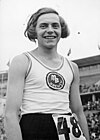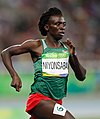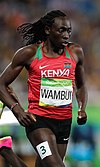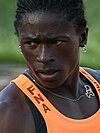Talk:List of intersex Olympians
| This article was nominated for deletion on 11 August 2024. The result of the discussion was redirect. |
| This is the talk page for discussing improvements to the List of intersex Olympians redirect. This is not a forum for general discussion of the article's subject. |
Article policies
|
| Find sources: Google (books · news · scholar · free images · WP refs) · FENS · JSTOR · TWL |
| The contentious topics procedure applies to this page. This page is related to gender-related disputes or controversies or people associated with them, which has been designated as a contentious topic. Editors who repeatedly or seriously fail to adhere to the purpose of Wikipedia, any expected standards of behaviour, or any normal editorial process may be blocked or restricted by an administrator. Editors are advised to familiarise themselves with the contentious topics procedures before editing this page. |
| This redirect does not require a rating on Wikipedia's content assessment scale. It is of interest to the following WikiProjects: | ||||||||||||||||||||||||||||||||
| ||||||||||||||||||||||||||||||||
| Text and/or other creative content from this version of List of LGBT Olympians and Paralympians was copied or moved into List of intersex Olympians with this edit on 06:39, 5 January 2023. The former page's history now serves to provide attribution for that content in the latter page, and it must not be deleted as long as the latter page exists. |
The nationally should be based on the country for which the athlete competed
[edit]In particular, Walasiewicz was born on 3 April 1911 in Wierzchownia (now Brodnica County), Congress Poland. Her family emigrated to the United States when she was just three months old. Her athletic career was entirely as an American. Wilkus (talk) 22:16, 3 May 2023 (UTC)
- She competed for Poland. These lists adhere to the "country" label being for the country/ies represented, so if you think you spot any other inconsistencies, please bring them up. Kingsif (talk) 23:01, 3 May 2023 (UTC)
Suggestion gathering: improvements to coverage of intersex and DSD athletes
[edit]Following a question and long discussion at my talkpage (notify @Hmlarson and Vaticidalprophet: as participants there), I think it has become clear that wider discussion of how Wikipedia's coverage of athletes with differences of sexual development (and/or athletes who have been discriminated against due to the belief of such at the time) can be improved. Though that should be wider than this article, with Sex verification in sports and Testosterone regulations in women's athletics being similar in scope, the discussion began about this article and I believe this is a neutral place to host it, i.e. there will not initially be more participants from one focus area than another. Appropriate WikiProjects will be notified. Initially, this topic is to gather suggestions for what should be improved and how this can be implemented. I imagine the subject area is covered by discretionary sanctions for gender-related topics, so this should be kept in mind. Otherwise, all comments welcome, with the aim to collect the most promising to develop an RfC or (if support is clear) to incorporate directly. Kingsif (talk) 06:28, 12 July 2023 (UTC)
- Notified: WT:SPORTS, WT:MED, WT:SEX, WT:LGBT, WT:OLYMPICS, WT:DISCR and Talk:Caster Semenya (related discussion currently there). Kingsif (talk) 06:36, 12 July 2023 (UTC)
- So, what stood out to me when looking over Testosterone regulations in women's athletics is that these guidelines have progressively tightened a ton since their introduction, and that there are additional local-guidelines that are even laxer than the original set were. Post-2019, we're talking about actually a very narrow group of people who we can inherently have a decent idea of the background of from their inclusion. Earlier...less so, even before we get into very early versions that don't address sex hormones per se (I'll get into that later).
- The post-2019 regulations are specifically about women with XY karyotypes who have testosterone levels well above most women (the limit is 5 nmol/L; see our own information on averages to see how that compares to female ranges) and who are physically able to process those levels. This is a minority of a minority of a minority. Most intersex women are not XY, and the most common disorders for XY intersex women -- which are already extremely rare -- involve either not producing that much testosterone or not processing it. This is still not a truly homogenenous grouping, and it still includes a lot of variance, but it's markedly moreso than 'intersex' as a whole; it's also exceptionally rare.
- Earlier, we have a period of about a year of that + congenital adrenal hyperplasia (which is also extremely masculinizing in its severe form, but with an XX karyotype -- so a very arbitrary distinction here, especially given it's about as common as all the post-2019 conditions combined). Before that, we have an incredibly expansive list of conditions that includes a lot of things no one except 1. some particularly expansive advocacy/self-ID/political definitions and 2. the IAAF from 2011-2018 defines as intersex. Most remarkably, PCOS (which around 10% of women have) is counted. So we have an astoundingly rapid swing from a definition of intersex that includes more people than most estimates for the entire LGBT acronym, to a definition that includes so few people these women make up a non-rounding-error proportion of everyone alive who counts under it. The vague balance here is that the definition of high testosterone used at the earlier point was particularly high, enough to approach the reference norms for men (and going to occur in only a tiny fraction of women with PCOS), but we're still talking about revolutionary definitional shifts.
- The individual probably most problematic wrt definitional shifts and having 'intersex' in the title is probably Dutee Chand, who if I understand our coverage of her right, was called out by a restriction even more absurd than the early IAAF one. Defining hyperandrogenism as above 2 nmol/L is...reasonable from a perspective of, say, endocrinologist referrals for someone distressed about PCOS symptoms, but definitely not something that crosses at all into calling a woman either of 'intersex' or 'DSD', because that's straight-up 'within what can reasonably be expected, given some people will fall slightly above or below reference ranges'. One thing we need to be careful about here is noting that, under this umbrella, the situations of Chand and Semenya are extremely not-comparable. They faced similar issues, but with extremely different underlying causes. These two women are at the extremes -- one falling under circumstances that a sizable fraction of non-intersex cis women do, and one falling under an extremely rare disorder that generally comes with a male gender identity -- and we need to be careful to make it clear that there's a lot of variety here. If not for the specific fact Chand was under an unusually restrictive ruleset and made her reaction a cause célèbre, we probably wouldn't include her; it's a mathematical certainty there are many other women like her competing in sports who never came to attention because they weren't under such rules.
- I definitely want to highlight that swing between the first ruleset and the third one -- it's enough to give you whiplash reading it. It's tricky to figure out a good scope here because there's a very clear intuitive scope (athletes who have been gender-controversial for endogenous rather than exogenous reasons), but as soon as you look too close you start seeing all these weird things. The list should make it clear somehow at a glance what rules people were under (if any) when concerns were raised about them, but that'll probably have to be brainstormed. Vaticidalprophet 06:59, 12 July 2023 (UTC)
- @Vaticidalprophet: I think this is well-argued, and the overarching suggestion is that the coverage would be improved if it included the regulations in force at the time. How about something like this? I would have suggested adding it to the note column already present, but I expect that wouldn't be as prominent as you feel is needed, and it would require repetition for several athletes: Kingsif (talk) 10:03, 12 July 2023 (UTC)
Suggested table formatting
| |||||||||||||||||||||||||||||||||||||||||||||||||||||||||||||||||||||||||||||||||||||||||||||||||||||||||||||
|---|---|---|---|---|---|---|---|---|---|---|---|---|---|---|---|---|---|---|---|---|---|---|---|---|---|---|---|---|---|---|---|---|---|---|---|---|---|---|---|---|---|---|---|---|---|---|---|---|---|---|---|---|---|---|---|---|---|---|---|---|---|---|---|---|---|---|---|---|---|---|---|---|---|---|---|---|---|---|---|---|---|---|---|---|---|---|---|---|---|---|---|---|---|---|---|---|---|---|---|---|---|---|---|---|---|---|---|---|---|
| |||||||||||||||||||||||||||||||||||||||||||||||||||||||||||||||||||||||||||||||||||||||||||||||||||||||||||||
- That's a very nicely done table. However, one suggestion, remove references to individual's sexuality (Semenya having a wife, Chand being lesbian). They are not relevant. Bondegezou (talk) 12:56, 13 July 2023 (UTC)
- Yeah, the notes are a holdover from when everyone was listed in one far-too-long list combining LGBTQ+ and intersex people (mentioning sexuality was relevant there) - everyone should feel welcome to edit the article itself to improve the notes! Kingsif (talk) 13:07, 13 July 2023 (UTC)
- The table looks good. I'm thinking about how best to edit the notes and contextualize the very different situations. re. Chand, this gives reference ranges for testosterone in all women, and it's possible to see the 2 nmol/L threshold is very low if you want to minimize 'false positives' -- that translates to 2000 pmol/L, so with a 95th percentile of 1595 pmol/L, we're likely talking about a percentage of 1% of women or higher. Without crossing into OR, it's imo defensible under CALC to note that "the threshold she was called out by is 2 nmol/L, 5% of women are above 1.6 nmol/L", but different people's interpretation of these things differ. (There's another stat I recall reading either cited onwiki or in a citation that gave markedly higher averages for sportswomen, which would be especially worth contrasting.) I think where we can we should be including what individual-details are known -- fr. ex. for Semenya we should outright say she has 5α-Reductase 2 deficiency, for the same reasons I gave on her talk, to clarify what makes her situation so unique.
- Another case that stands out to me somewhat is Beatrice Masilingi and Christine Mboma, who were disqualified by rules that apply specifically to XY athletes, but the Namibian statements were that they were XX. It's hard to tease out what 'actually happened' here, because much of the reporting seems to just talk about 'high testosterone' without acknowledging or even obviously being aware that these rules apply only to XY athletes. Their articles don't help (and seem to be a little SYNTH-y). We should clarify somehow that it's much less clear than for some other women disqualified by these rules what happened, but it's so unclear I'm not even entirely sure how to do so. Vaticidalprophet 23:13, 13 July 2023 (UTC)
The commonality of an intersex condition among the general population (which isn't precisely known for many of them) isn't a good measure of the commonality among elite athletes. This true for many characteristics; not just unusual endocrine profiles are observed, but many sports have disproportionate numbers of people who are far taller or shorter than average, for example. (t · c) buidhe 18:53, 14 July 2023 (UTC)
- @Vaticidalprophet: Feel free to edit the notes on the athletes at the article, improving Semenya's particularly given her profile. For the Namibians, perhaps just saying that there's a lack of clarity. @Buidhe: I remember reading research that looked at the prevalence of 'high testosterone' in female athletes (yes, higher than the general population) - I think it was actually when I was reading about Spajari, because it (also) mentioned there are male athletes with female-levels of testosterone who manage to reach high levels. Kingsif (talk) 19:48, 14 July 2023 (UTC)
- My own personal opinion on the subject is that either one could argue that some DSDs / intersex conditions make a person "biologically male" and therefore excluded from women's sports unless they meet the same criteria required of transgender athletes, or else you could argue that the purpose of women's sports is to find out what woman is best, including the sum total of intersex and non intersex women. the IAAF seems to want to have it both ways but if an intersex condition doesn't make someone any less female why would it be treated differently than any other innate advantage
- I also believe that medical treatment should only be provided for the benefit of the person involved. It's rather shocking to me that some medical practitioners are willing to perform irreversible surgeries in order to assuage parental anxiety. Likewise I don't think it can be ethical to prescribe medicine for the benefit of other competitors. (t · c) buidhe 18:24, 15 July 2023 (UTC)
- @Vaticidalprophet: Feel free to edit the notes on the athletes at the article, improving Semenya's particularly given her profile. For the Namibians, perhaps just saying that there's a lack of clarity. @Buidhe: I remember reading research that looked at the prevalence of 'high testosterone' in female athletes (yes, higher than the general population) - I think it was actually when I was reading about Spajari, because it (also) mentioned there are male athletes with female-levels of testosterone who manage to reach high levels. Kingsif (talk) 19:48, 14 July 2023 (UTC)
Events restricted with 2019 ruling
[edit]While most sources only discuss the middle distance running events to which the 2019 ruling applies, this article mentions that hammer throw is another event that is restricted. (It also specifies that football is not, with this being why Barbra Banda faced no issues at the Olympics.) I imagine there is a full list published by the IOC somewhere, and then we should be able to add the exact restrictions. Kingsif (talk) 04:16, 18 July 2023 (UTC)
2023 updates
[edit]Some of the information to be added here relating to 2023 updates can be seen at Concerns_and_controversies_at_the_2024_Summer_Olympics#Bans_on_transgender_women_and_DSD_restrictions. There's also updates on Semenya's legal case, too. Kingsif (talk) 23:20, 29 July 2024 (UTC)
New discussion on how to present article
[edit]Pinging participants of last year's discussion on similar topic: @Vaticidalprophet, Buidhe, and Bondegezou:. I'm sure we've seen some of the Olympics incidents recently, be it Ilona Maher being called a man for being good at rugby, the Zambian footballers being stigmatised by a certain radical Australian journalist, or more seriously the moral outrage and misinformation about Imane Khelif. And while this listicle gets fewer pageviews than their articles, generally, I would like to offer brainstorming for ways to improve the presentation of this list, associated prose, and the article in general - in order to improve clarity on the athletes and their conditions, basically to prevent misunderstandings that could further the misinformation knocking around.
My first thought would be to expand this listicle with more of the information at the "Sex verification and intersex athletes" section of the history article, making it more about the relationship of the Olympic Games with athletes who exist outside of "the accepted binary", and having a list just as part of that. Information from Testosterone regulations in women's athletics and Sex-determining region Y protein could also be included. Using a term different to "intersex" in the title may also be a benefit, especially in terms of the general public often presuming that means "hermaphrodite" and making assumptions, while the list includes a variety of conditions and several of seeming Hyperandrogenism. I am happy to undertake the work myself, but would value input on whether others think this is the best route, as well as other ideas. Kingsif (talk) 22:35, 1 August 2024 (UTC)
- I would oppose a move as intersex is clearly the common name, and it is used to describe hyperandrogenism as well. I'm not a big fan of assuming our readers are incapable of understanding normal encyclopedic content, nor do I understand what you mean by "hermaphrodite" since this is not a classification for human beings and is considered a slur by many intersex people. (t · c) buidhe 01:38, 2 August 2024 (UTC)
- I don't really understand what you're asking at the end there - I said that a growing amount of the public are conflating the term "intersex" with the outdated (and, as you say, offensive) "hermaphrodite". Social media (and increasingly traditional media) writing prejudiced things about intersex athletes, including being deliberately ambiguous about sex and gender, is leading sections of the public to make negative assumptions when seeing the term "intersex" applied to athletes. While we don't change encyclopedic content as a reaction to outside mood, I suggested a move (perhaps to something in sentence format rather than a single adjective) as a form of clarification - the term "intersex" being increasingly separated from its meaning, is a reason that using it could unfortunately make the topic unclear. Kingsif (talk) 02:21, 2 August 2024 (UTC)
- I still don't understand which "negative assumptions" you are referring to specifically nor what you mean by "hermaphrodite". The vast majority of people don't know anything about this issue for sure, but I'm unconvinced that changing the title would help. (t · c) buidhe 03:30, 2 August 2024 (UTC)
- Wider social media has just discovered the word intersex and a good handful are assuming it means "man who thinks he can pass for a woman", much like people did with "hermaphrodite", and are applying it to Imane Khelif specifically. Kingsif (talk) 09:46, 2 August 2024 (UTC)
- I don't agree with changing Wikipedia content to cater to the lowest common denominator on social media, especially when this interpretation is going to be excluded by the actual content of the article. (t · c) buidhe 14:59, 2 August 2024 (UTC)
- Wider social media has just discovered the word intersex and a good handful are assuming it means "man who thinks he can pass for a woman", much like people did with "hermaphrodite", and are applying it to Imane Khelif specifically. Kingsif (talk) 09:46, 2 August 2024 (UTC)
- I still don't understand which "negative assumptions" you are referring to specifically nor what you mean by "hermaphrodite". The vast majority of people don't know anything about this issue for sure, but I'm unconvinced that changing the title would help. (t · c) buidhe 03:30, 2 August 2024 (UTC)
- I don't really understand what you're asking at the end there - I said that a growing amount of the public are conflating the term "intersex" with the outdated (and, as you say, offensive) "hermaphrodite". Social media (and increasingly traditional media) writing prejudiced things about intersex athletes, including being deliberately ambiguous about sex and gender, is leading sections of the public to make negative assumptions when seeing the term "intersex" applied to athletes. While we don't change encyclopedic content as a reaction to outside mood, I suggested a move (perhaps to something in sentence format rather than a single adjective) as a form of clarification - the term "intersex" being increasingly separated from its meaning, is a reason that using it could unfortunately make the topic unclear. Kingsif (talk) 02:21, 2 August 2024 (UTC)
- Thanks, Kingsif for the suggestion. I'm not at all certain, but I think this article works OK for those Olympians who identify as or are clearly referred to by reliable sources as intersex. There are then other cases where an athlete's gender identity is questioned, but where we don't have reason to call them "intersex" (that is, insufficient citations under WP:BLP), as I believe to be the case with Imane Khelif (but I've not followed her case closely). There are then further cases where there is entirely unfounded abuse, as with Ilona Maher. All of these may be worth discussion on Wikipedia. So, maybe, keep this article and have a second article along the lines you suggest about gender issues at the Olympics (but I wouldn't describe that in terms of
the relationship of the Olympic Games with athletes who exist outside of "the accepted binary"
as the athletes themselves don't necessarily view themselves in those terms). Bondegezou (talk) 09:28, 2 August 2024 (UTC)- Just call the article "List of sex verification in the Olympics controversies" or something like that. Someone will propose a better title if they find it Trade (talk) 10:56, 2 August 2024 (UTC)
- Not all of them have been controversial. This was part of my thinking to convert the article to be about sex verification and include a list of cases. Kingsif (talk) 11:01, 2 August 2024 (UTC)
- Fine by me Trade (talk) 12:33, 2 August 2024 (UTC)
- for me too Braganza (talk) 17:55, 2 August 2024 (UTC)
- Not all of them have been controversial. This was part of my thinking to convert the article to be about sex verification and include a list of cases. Kingsif (talk) 11:01, 2 August 2024 (UTC)
- Just call the article "List of sex verification in the Olympics controversies" or something like that. Someone will propose a better title if they find it Trade (talk) 10:56, 2 August 2024 (UTC)
- Note I've started Draft:Sex verification and intersex athletes at the Olympic Games. Kingsif (talk) 01:19, 4 August 2024 (UTC)
This article has been posted to 4chan and may be subject to edit warring
[edit]Locking the page may become necessary amid the recent Olympics-related culture war. 1101 (talk) 00:53, 3 August 2024 (UTC)
Related content: List of LGBTI Olympians and Paralympians#Intersex athletes
[edit]We should probably aim to keep that section and this article broadly consistent, and subject to the same sourcing standards. As it stands we have a very lax list with minimal sourcing in one, and much stricter such in the other. 109.255.211.6 (talk) 16:38, 9 August 2024 (UTC)
- Redirect-Class Sexology and sexuality articles
- Low-importance Sexology and sexuality articles
- WikiProject Sexology and sexuality articles
- Redirect-Class LGBTQ+ studies articles
- WikiProject LGBTQ+ studies articles
- Redirect-Class Olympics articles
- NA-importance Olympics articles
- WikiProject Olympics articles
- Redirect-Class List articles
- NA-importance List articles
- WikiProject Lists articles












